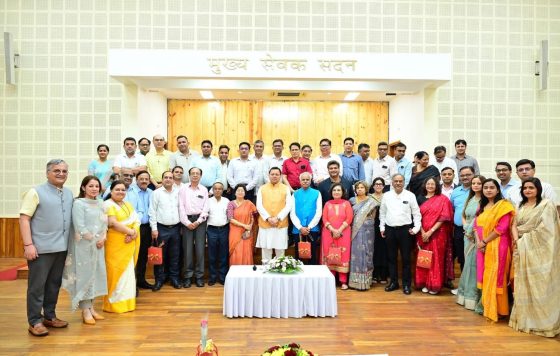Dr SK Varun
In India, the risk of dengue has increased in recent years due to rapid urbanization, lifestyle changes and deficient water management including improper water storage practices in urban, peri-urban and rural areas, leading to proliferation of mosquito breeding sites. The disease has a seasonal pattern i.e. the cases peak after monsoon, and it is not uniformly distributed throughout the year. However, in the southern states and Gujarat the transmission is perennial. During epidemics, infection rate among those who have not been previously exposed to the virus are often 40 to 50 per cent, but can also reach 80 to 90 per cent.
Dengue viruses are arboviruses capable of infecting humans, and causing disease. Aedes aegypti and Aedes Albopictus are the two most important vectors of dengue. All the four serotypes i.e. dengue 1, 2, 3 and 4 have been isolated in India but at present DENV-1 and DENV-2 serotypes are widespread. Infection with any one serotype confers lifelong immunity to that virus serotype.
These infections may be asymptomatic or may lead to (a) “classical” dengue fever, or (b) dengue hemorrhagic fever without shock, or (c) dengue hemorrhagic fever with shock. Dengue fever is a self-limiting disease and represents the majority of cases of dengue infection.
The Aedes mosquito becomes infective by feeding on a patient from the day before onset to the 5th day of illness. Once the mosquito becomes infective, it remains so for life. Their population fluctuates with rainfall and water storage. Its life span is influenced by temperature and humidity, survives best between 16°C-30°C and a relative humidity of 60-80 per cent. It breeds in the containers in and around the houses. The failure of urban authorities to provide civil amenities and poor public health infrastructure raises the potential for the vector to breed at high level and makes the environment transmission conducive.
The host factors contribute to more severe disease and its complications infants and elderly, obesity, pregnancy, peptic ulcer disease, women who are in menstruation or have abnormal bleeding, hemolytic disease such as G-6PD, thalassemia and other haemoglobinopathies. high risk patients are chronic diseases such as diabetes mellitus, hypertension, asthma, ischaemic heart disease, chronic renal failure, liver cirrhosis; and patients on steroid oranalgesics treatment.
Dengue virus infection may be asymptomatic or may cause undifferientiated febrile illness, dengue fever(DF), or dengue haemorrhagic fever (DHF) including dengue shock syndrome (DSS). Infants, children and adults who have been infected with denuge virus, especially for the first time (primary dengue infection), may develop a simple fever indistinguishable from other viral infection and rashes may accompany the fever or may appear during defervescence. The illness is characterized by an incubation period of 3 to 10 days (commonly 5-6 days). The onset is sudden, with chills and high fever, intense headache, muscle and joint pains orbital pain , extreme weakness, anorexia, constipation, altered taste sensation, colicky pain. The skin eruptions appear in 80 percent of cases. It may be accompanied by itching .
Dengue haemorrhagic fever (DHF) is a severe form of dengue fever. The course of dengue illness can be divided into three phases-febrile phase, critical phase and recovery phase.
Following an incubation period of four to six days, the illness commonly begins abruptly with high fever accompanied by facial flushing and headache. Anorexia, vomiting, epigastric discomfort, tenderness at the right costal margin and generalized abdominal pain are common. The major changes that determine the severity of disease in DHF and differentiate it from other fever are plasma leakage and abnormal haemostasis, as manifested by a rising haematocrit value and moderate to marked thrombocytopenia.
Around the time of defervescence, when the temperature drops an increase in capillary permeability in parallel with increasing haematocrit levels may occur. This marks the beginning of the critical phase. The period of clinically significant plasma leakage usually lasts 24-48 hours. Shock occurs when a critical volume of plasma is lost through leakage. It is often preceded by warning signs of abdominal pain or tenderness, persistent vomiting, clinical fluid accumulation, mucosal bleeding, lethargy, restlessness, liver enlargement and oliguria severe organ impairment such as severe hepatits, encephalitis or myocarditis and/or severe bleeding may also develop without obvious plasma leakage or shock. in Recovery phase a gradual reabsorption of extravascular compartment fluid takes place in the following 48-72 hours .
Any person who has dengue fever with thrombocytopenia and haemoconcentration and presents with abdominal pain, black tarry stools, epistaxis, bleeding from the gums and infection etc needs to be hospitalized. All these patients should be observed for signs of shock.
Oral rehydration should he given along with antipyretics like paracetamol, sponging. In general there is no need to give prophylactic platelet even at< 20,000/cu.mm. Isolation of the patient under bed-nets during the first few days; individual protection against mosquitoes.The personal prophylactic measures are wearing of full sleeves shirts and full pants; use of mosquito repellent creams, liquids, coils, mats etc.; use of bed-nets for sleeping infants and young children during day time to prevent mosquito bite. The environmental measurements are detection and elimination of mosquito breeding places, management of roof tops, porticos and sunshades, proper covering of stored water, observation of weekly dry day.
Dr S K Varun
senior Consultant physician and diabetologist
department of internal medicine
Synergy Institute of Medical Sciences Dehradun UK.
 Dainik Nation News Portal
Dainik Nation News Portal




